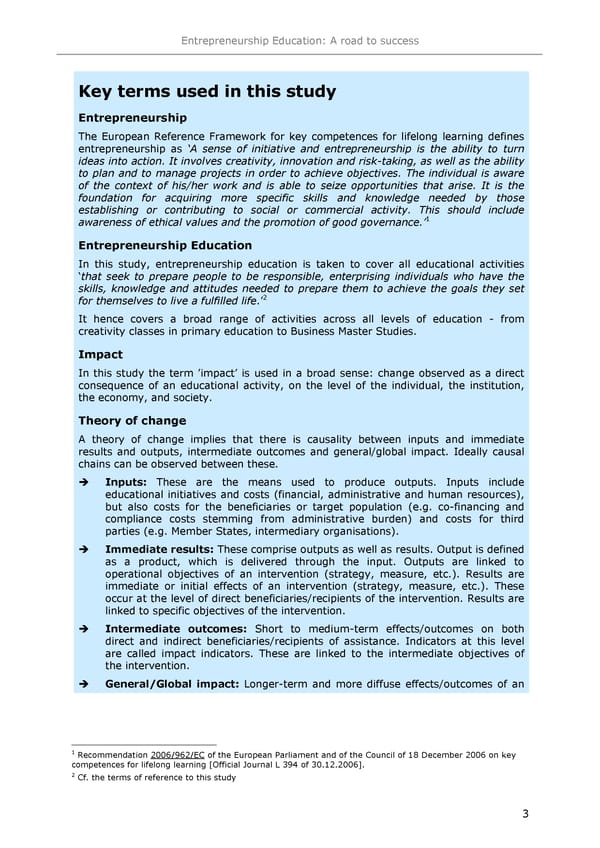Entrepreneurship Education: A road to success Key terms used in this study Entrepreneurship The European Reference Framework for key competences for lifelong learning defines entrepreneurship as 8A sense of initiative and entrepreneurship is the ability to turn ideas into action. It involves creativity, innovation and risk-taking, as well as the ability to plan and to manage projects in order to achieve objectives. The individual is aware of the context of his/her work and is able to seize opportunities that arise. It is the foundation for acquiring more specific skills and knowledge needed by those establishing or contributing to social or commercial activity. This should include 1 awareness of ethical values and the promotion of good governance.9 Entrepreneurship Education In this study, entrepreneurship education is taken to cover all educational activities 8that seek to prepare people to be responsible, enterprising individuals who have the skills, knowledge and attitudes needed to prepare them to achieve the goals they set 2 for themselves to live a fulfilled life.9 It hence covers a broad range of activities across all levels of education - from creativity classes in primary education to Business Master Studies. Impact In this study the term 9impact9 is used in a broad sense: change observed as a direct consequence of an educational activity, on the level of the individual, the institution, the economy, and society. Theory of change A theory of change implies that there is causality between inputs and immediate results and outputs, intermediate outcomes and general/global impact. Ideally causal chains can be observed between these. Inputs: These are the means used to produce outputs. Inputs include educational initiatives and costs (financial, administrative and human resources), but also costs for the beneficiaries or target population (e.g. co-financing and compliance costs stemming from administrative burden) and costs for third parties (e.g. Member States, intermediary organisations). Immediate results: These comprise outputs as well as results. Output is defined as a product, which is delivered through the input. Outputs are linked to operational objectives of an intervention (strategy, measure, etc.). Results are immediate or initial effects of an intervention (strategy, measure, etc.). These occur at the level of direct beneficiaries/recipients of the intervention. Results are linked to specific objectives of the intervention. Intermediate outcomes: Short to medium-term effects/outcomes on both direct and indirect beneficiaries/recipients of assistance. Indicators at this level are called impact indicators. These are linked to the intermediate objectives of the intervention. General/Global impact: Longer-term and more diffuse effects/outcomes of an 1 Recommendation 2006/962/EC of the European Parliament and of the Council of 18 December 2006 on key competences for lifelong learning [Official Journal L 394 of 30.12.2006]. 2 Cf. the terms of reference to this study 3
 Entrepreneurship Education Page 6 Page 8
Entrepreneurship Education Page 6 Page 8